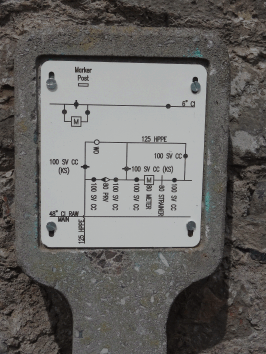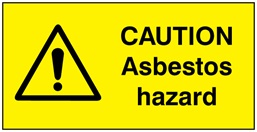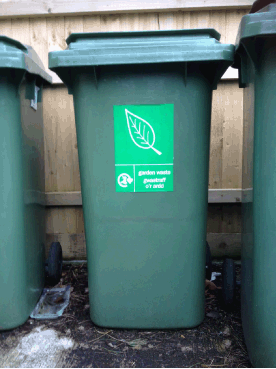You probably heard about the Queen's asbestos problems earlier this week (and if you didn't, go and read the blog we wrote about it). Here are some other health and safety stories that didn't get quite so much attention this week...
Stafford Borough Council were hit with a £20,000 fine (plus costs) on Wednesday after an HSE inspection found that "a suitable risk assessment had not been carried out" at a local theatre. The investigation was carried out after a 33-year-old worker was injured in a fall at Stafford Gatehouse Theatre and left unable to work for more than two months afterwards.
*
A company in West Yorkshire has admitted to breaching health and safety regulations in relation to a fatal incident that occurred in late 2012. Keith Jarman, a 65-year-old man from Doncaster, was killed by a falling metal cage roughly two and a half years ago whilst making a deliver to an Oasis store in Hebden Bridge; the managing director of Oasis Limited entered a guilty plea on Wednesday, and the company will be sentenced in September.
*
Car manufacturers Hyundai are under fire in America, with the United Auto Workers union petitioning for health and safety improvements in the company's factories. According to Buzzfeed, the workers are particularly concerned about "exposure to unsafe chemicals" - read the full story here.
*
Finally, a couple of updates from Alton Towers, which is still reeling from the much-publicised Smiler crash earlier this month. The theme park has re-opened its gates since the accident, but visitors are complaining that too many attractions have been closed, with many suggesting that Alton Towers should lower their admission prices to reflect this.
According to the Express & Star, "Park-goers...have queued up for more than an hour for some attractions only to see them shut with no prior warning for safety testing." However, a representative for Alton Towers stated, "any delays that we are experiencing now are within our expected level."
Meanwhile, Joe Pugh - one of the people injured in the Smiler crash - was released from hospital on Tuesday; according to the Daily Star, Joe, his girlfriend Leah Washington (who had her leg amputated in the wake of the accident), and a third victim have all received payouts from the theme park's insurers.
More health and safety news and insight here.
Reports are circulating that Queen Elizabeth and her family may soon have to vacate Buckingham Palace to make way for 150 million pounds' worth of repair work. The cause? Asbestos, among other issues.
According to The Times, the Royal Family has spent £300,000 on asbestos removal in the past year, and yet "vast swathes of the palace still require asbestos to be removed from the walls and other cavaties". The palace also need a new heating system (this alone could cost upwards of £1 million), along with a whole lot of long-overdue maintenance and repair work.
Still, it's the asbestos that's clinching the headlines...
...and it's not hard to see why. We tend to imagine that asbestos only exists in run-down buildings that haven't been used since the 1980s, but deep down, we know that this isn't the case - earlier this year, we told you that asbestos is still present in a shocking 86% of UK schools, and the news about Buckingham Palace further demonstrates that asbestos really can be found everywhere.
And that's quite a scary thought. Asbestos has been banned more or less outright since 1999, and with good reason: it's a severe health hazard that can cause mesothelioma, lung cancer, and several other life-threating illnesses. Asbestos-related diseases claim many thousands of lives every year, from tradespeople to schoolteachers, and health and safety authorities are still struggling to bring the death toll down.
With all of this in mind, here are a few quick guidelines for dealing with asbestos on your premises. Perhaps Her Majesty might find them useful?
- DO NOT ATTEMPT TO REMOVE THE ASBESTOS YOURSELF. Asbestos removal should only be carried out by qualified professionals with the appropriate protective equipment.
- Asbestos is safer when left undisturbed - STAY AWAY FROM ASBESTOS and ENSURE THAT OTHERS DO THE SAME. We recommend using asbestos signs to identify the hazard, and warning tape to keep people away from the affected area.
- DEAL WITH THE PROBLEM AS SOON AS POSSIBLE. Asbestos is a serious health risk even when left alone, so don't just forget about it once it's been cordoned off - call in a professional to get rid of it (don't worry, it probably won't cost £300,000...unless you live in a palace!)
Want to see more stories like this? Follow Label Source on Twitter!
Any labels used outdoors are subject to the effects of ultra violet rays from sunlight. To mitigate this effect which has the tendency to fade label colours, it is important to extend the label life by choosing products, which are UV stable. One such material type is external grade engraving laminate, which is durable and provides colour fast identification products for a longer period.

These labels are used on instrument enclosures for water, gas, electricity, telecommunications, local authorities, construction and rail sectors, and provide location identification, serial numbering, barcoding and operational safety information.
Such labels can be designed to your own requirement in a variety of colour combinations, and can be fixed by adhesive backing or fixing holes for screws, self-tappers or rivets.
Please contact us by e-mail on sales@labelsource.co.uk for further information or a quotation.
Earlier this week, we told you all about UK Health & Safety Week, which is currently on its last day for 2015. That blog post included the following list:
- Mesothelioma and other asbestos-related illnesses
- Respiratory diseases
- Musculoskeletal disorders
- Skin complaints
- Hand arm vibration
- Stress and mental health problems
There are the specific workplace hazards that the organisers of Health & Safety Week wanted to address with this year's event. Today, we're going to tell you how Label Source can help you and your employees to steer clear of these problems.

Asbestos-Related Illnesses
Our asbestos range is home to many labels and warning signs that can be used to identify asbestos hazards and warn everyone to stay clear. Some of these products also give instructions on how to safely deal with asbestos.
Respiratory Diseases
If your employees are being exposed to smoke, fumes, spores, vapours, sprays, or airborne particles, this sign will remind them of the PPE they should be using to minimise the risk of respiratory diseases.
Musculoskeletal Disorders
Improper manual handling techniques are perhaps the most common cause of musculoskeletal disorders. Visit our Manual Handling Safety department for a range of products that will help you and your employees to follow best practices when lifting heavy objects.
Skin Complaints
Do your employees work with hazardous chemicals or other potential irritants? Make sure that all dangerous substances and workspaces are clearly identified with the appropriate signs/label Hand Arm Vibration
Hand Arm Vibration
Some hand-held tools vibrate violently when in use, and this can lead to HAVS (Hand Arm Vibration Syndrome) and other painful disorders. To prevent this, carry out a full vibration risk assessment and label your equipment appropriately to inform workers of the recommended safe use periods
Stress
Obviously, stress can't be attributed to one sole factor, and to truly address stress in your workplace may require a substantial re-working of your current practices. Still, our stress management posters may be a good place to start - they identify some common causes and recommend ways to reduce stress in a working environment.
Give Label Source a call on 0800 3761 693 if you need any help to improve the health and safety standards of your workplace.
The pressure on organisations, both public and private, to have waste management plans is unswerving, and the challenge to improve is constant. Many EU directives have a direct bearing on the targets laid down for recycling in England, Wales, Scotland and Northern Ireland.
Included in the legislation is the Landfill Directive 1999 laying down progressive targets for reducing disposal by landfill; the EU Waste Framework Directive covering a waste hierarchy ranging from prevention, re-use or recycling, energy recovery and disposal; and others such as The Packaging Directive for the recycling of packaging waste.

So no matter if the waste is generated by households, commerce or industry there is an ongoing pressure to improve waste performance, by diverting waste from landfill, improve recycling schemes, and a reduction in overall waste.
Label Source has a range of recycling signs to help manage waste segregation and recovery by clearly identifying waste streams on bins, containers, waste collection sites and waste treatment facilities. Our colour coded WRAP range identifies groupings of waste from automotive, electrical, mixed glass, garden waste, food waste, metals, mixed recycling, paint, plastics, textiles , building materials, and wood and timber. These are suitable for organisations seeking to implement ISO 14001 environmental standards, or for eco-audits.